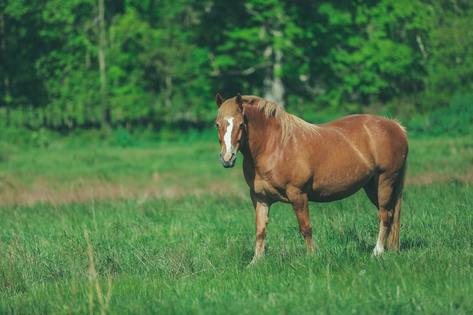
Are You & Your Horse Ready For Bitting Advice? The Steps You Need To Consider First
Equestrian Advice & Guides All Disciplines
Build your business profile for FREE and expose your services to thousands of potential clients!
Create my profile now!
It seems like only yesterday we were worrying about a lack of grass and forage stocks, yet after some much needed rain throughout August, our fields are once again looking healthy and plentiful. The sudden grass growth caused for owners to be vigilant as the rapid sugar production could have lent itself to cases of late-Summer laminitis and obesity. As we welcome in the new season, what can you do to ensure your horse is happy and healthy?
It’s well documented that sugar is as damaging for your horse as it is for humans. Having battled with burnt up fields and a severe grass shortage, the sudden downpours were a welcomed change as we saw our fields return to their glorious green shade. But, this Autumnal rain, particularly coupled with warm daytime temperatures has led to an increase in grass sugar content. The sugar content is in fact worsened after a lengthy drought making it of particular concern at the moment.
While it can be really tempting to turn out as much as possible now the temperature is more bearable and we have grass again, you mustn’t change your horses routine too quickly. Grass sugar content is still at its highest at the hottest point of the day, before gradually declining as we welcome in the evening. The lowest point of sugar content will be in the early hours of the morning before it starts to slowly increase again. Therefore to ensure your horse's health, continue to turn out overnight, well into the Autumn months. This is true even though our daytime temperature may only peak at 20ºC.
When your horse is stabled during the day, continue to feed forage as normal. Abrupt daytime starvation due to the sudden grass growth is actually detrimental to your horse's health as it causes fat stores in the body to be mobilised and enter the bloodstream - this is where the fat can damage the heart. Instead of limiting dry matter quantity, try encouraging the horse to spend longer chewing and choose a forage that has fewer calories per kg.
Steaming hay can also be beneficial in ensuring sugar restrictions. As the grass sugar content continues to climb as we head into Autumn it’s essential that we monitor the sugar content in the forage we provide. Studies by Haygain have found that steaming forage actually reduces the Water Soluble Carbohydrate content, whereby soaking hay actually increases this content.
Horses are natural grazers; in the wild, they’ll spend up to 18 hours of their day grazing. With our current management, we’re taking them away from this age-old method. But why do they graze so extensively and what are the benefits of doing so?
When horses continually graze, they’re providing a forage buffer mat in the stomach. The importance of this cannot be underestimated. Without this forage buffer mat, acid can be splashed from the lower region of the stomach to the sensitive upper region, resulting in exceptionally painful ulcers. Ulcers occur in the horse’s stomach when the digestive acids contact the stomach lining in the upper regions of the stomach. Unlike humans who produce acid only during meals, the horse’s stomach produces acid 24/7. This is why they need to eat throughout the day.
Studies indicate the prevalence of gastric ulcers is high:
93% of Racehorses
63% of Performance horses
37% of Leisure horses (that’s a 1 in 3 chance of the hack or companion developing gastric ulcers!)
Foals are also at risk, one study found 50% of foals develop stomach ulcers, particularly in the first few months of life while another found 84% of pre-weaned foals had ulcers and 100% had ulcers after weaning.
The Haygain Forager Slow Feeder is great for stabled horses as it’s the natural way to slow the pace a horse eats. When horses are fed in haynets or given loose forage on the stable floor, they’re more likely to gorge and finish their ration in a much quicker time, than when compared to eating from the Forager. The Forager’s regulator grid also ensures smaller bites of forage and increased amounts of chewing, which helps maintain a flow of saliva, acting as a natural buffer to stomach acid.
Starvation from forage or grass only worsens the problem. Many horses will gorge on their daily/overnight ration with studies by Haygain finding they finish their total amount within 4 hours. The result is that they may then spend up to 12 hours with no forage, particularly in the Winter months when they’re fed and brought in from the field so much earlier. This is a concurring figure and the acknowledgement of such led to the design and development of the Forager Slow Feeder.
The Forager slow feeder from Haygain is the natural way to slow the pace a horse eats, reducing the risk of colic, gastric ulcers, obesity and laminitis. It imitates natural grazing behaviour and slows the pace of eating so there is always forage in the stomach, creating a protective mat to prevent stomach acid splashing and causing gastric ulcers. The Forager's Regulator grid ensures smaller bites of forage and increased amounts of chewing, which helps maintain a flow of saliva, acting as a natural buffer to stomach acid.
A continual flow of forage also ensures plenty of saliva passes into the stomach. Saliva contains bicarbonate with reduces the acidity in the stomach, lowering the chances of ulcers developing.
For more information, please visit www.haygain.co.uk or call 03332005233.

